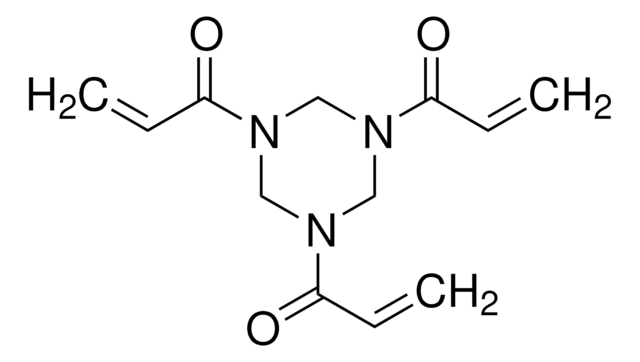추천 제품
양식
solution
Quality Level
사용
sufficient for 10 blots (11921673001 [100 cm2])
sufficient for 60 blots (11921681001 [100 cm2])
포장
pkg of 100 mL (11921673001)
pkg of 6 × 100 mL (11921681001)
제조업체/상표
Roche
저장 온도
2-8°C
관련 카테고리
애플리케이션
Western Blocking Reagent is used as a general blocking agent during western blotting experiments and immunofluorescence staining. The reagent is used in steps such as blocking the membrane, membrane washing steps, and diluting detection antibodies.
품질
Each lot is function tested (dot blot).
물리적 형태
The Western Blocking Reagent is a 10x solution that contains 10% purified casein protein in maleic-acid buffer.
제조 메모
Working solution: PREPARATION OF WORKING SOLUTIONS
Note: Since sodium azide inhibits POD, it must not be used as antimicrobial agent when using POD-conjugates.
Note: 0.1% Tween 20 is suitable for the most applications, but—depending on the membrane and on the antibody used—different detergents (like SDS, Triton X-100 and Nonidet P40 and detergent concentrations from 0.01 to 1% may lead to better results.
Note: Since sodium azide inhibits POD, it must not be used as antimicrobial agent when using POD-conjugates.
Note: The concentration of the blocking reagent is an important parameter for improvement of the signal to noise ratio in Western blots. If high background appears even under optimized antibody concentrations, increase the concentration of the blocking reagent during the antibody incubations and washing steps from 0.5% to 1%. In case of weak signals even with prolonged antibody incubations lower the concentration of blocking reagent during the antibody incubations and washing steps from 0.5% to 0.1%.
- Tris buffered saline (TBS), pH 7.5
Note: Since sodium azide inhibits POD, it must not be used as antimicrobial agent when using POD-conjugates.
- TBS-Tween (TBST)
Note: 0.1% Tween 20 is suitable for the most applications, but—depending on the membrane and on the antibody used—different detergents (like SDS, Triton X-100 and Nonidet P40 and detergent concentrations from 0.01 to 1% may lead to better results.
- Blocking solution (1%)
Note: Since sodium azide inhibits POD, it must not be used as antimicrobial agent when using POD-conjugates.
- Blocking solution (0.5%)
- Antibody solutions
Note: The concentration of the blocking reagent is an important parameter for improvement of the signal to noise ratio in Western blots. If high background appears even under optimized antibody concentrations, increase the concentration of the blocking reagent during the antibody incubations and washing steps from 0.5% to 1%. In case of weak signals even with prolonged antibody incubations lower the concentration of blocking reagent during the antibody incubations and washing steps from 0.5% to 0.1%.
기타 정보
For life science research only. Not for use in diagnostic procedures.
Storage Class Code
12 - Non Combustible Liquids
WGK
WGK 1
Flash Point (°F)
does not flash
Flash Point (°C)
does not flash
The PINK1/Parkin-mediated mitophagy is compromised by PD-associated mutations.
Geisler S
Autophagy, 6(7), 871-878 (2010)
Does FACS perturb gene expression?
Richardson GM, et al.
Cytometry. Part A : the Journal of the International Society For Analytical Cytology, 87, 166-175 (2015)
Increase in cardiac myosin binding protein-C plasma levels is a sensitive and cardiac-specific biomarker of myocardial infarction
Govindan S, et al.
American Journal of Cardiovascular Disease, 3, 60-70 (2013)
Cell-free synthesis of cytochrome bo3 ubiquinol oxidase in artificial membranes
Yildiz AA, et al.
Analytical Biochemistry, 423, 39-45 (2012)
Generation of IgG-Fc Glycovariants Using Recombinant Glycosidases and Glycosyltransferases
Quast I, et al.
The Journal of Clinical Investigation (2015)
자사의 과학자팀은 생명 과학, 재료 과학, 화학 합성, 크로마토그래피, 분석 및 기타 많은 영역을 포함한 모든 과학 분야에 경험이 있습니다..
고객지원팀으로 연락바랍니다.








